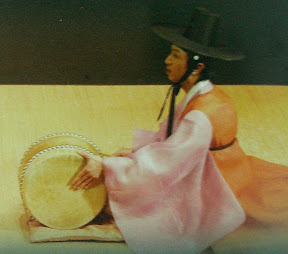Two other highlights of the Chongdong theatre show were showcases of the Pansori and Ogomu styles, both scaled-down, but hugely effective versions of quintessential Korean folk performances.
Pansori, described as 'the world's most beautiful monodrama', consists of mythical stories spoken and sung by a 'soriggon' performer, accompanied by a 'gosu' drummer. Beginning as an oral folk tradition in the 17th century, Pansori is a stylised, ritualistic theatrical form, which became popular in the late 19th century, but had almost disappeared by the 1960s, when it was rescued from obscurity by being designated as a 'National Intangible Cultural Property'.
Traditional Pansori performances could last for up to five hours, with the exact shape of the stories governed by the individual performer's improvised whims. A rasping voice was preferred, so a typical sorriggon training regime involved walking to a remote spot and shouting into the mountains. Unsurprisingly, this was a largely male pastime, but the Chongdong's female soriggon did a superb job of suggesting the richness and variety of the form, while also seeming to put her own mischievous stamp on it.
From and original cycle of 12 stories, only five survive today, and we were presented with snippets from four of these, in an intense 15 minute display of vocal dexterity and emotional range. With simple, expressive gestures, a paper fan and an incredible variety of rhythms and timbres, the performer delivered the monologues in a passionate, direct way, which allowed their essence to jump over the language barrier. The stories, of tragic love, greedy wives and deceptive animals, also have plenty of scope for strong characterisation, and the soriggon switched between protagonists with a light, assured touch.
An extra level of intimacy was provided by the gosu, who added sparse rhythms and acted as a kind of non-linguistic chorus, nodding in agreement and making sympathetic noises at particularly dramatic or humorous moments. The drummers' slightly stoned, wide-eyed appearance along with the inventive flow of the language, gave the lighter moments of the performance the feeling of a Daisy Age hip hop show. The overall effect was hugely engaging and a little dreamlike, with simple ingredients coming together to create something timeless and celebratory.

Pansori, described as 'the world's most beautiful monodrama', consists of mythical stories spoken and sung by a 'soriggon' performer, accompanied by a 'gosu' drummer. Beginning as an oral folk tradition in the 17th century, Pansori is a stylised, ritualistic theatrical form, which became popular in the late 19th century, but had almost disappeared by the 1960s, when it was rescued from obscurity by being designated as a 'National Intangible Cultural Property'.
Traditional Pansori performances could last for up to five hours, with the exact shape of the stories governed by the individual performer's improvised whims. A rasping voice was preferred, so a typical sorriggon training regime involved walking to a remote spot and shouting into the mountains. Unsurprisingly, this was a largely male pastime, but the Chongdong's female soriggon did a superb job of suggesting the richness and variety of the form, while also seeming to put her own mischievous stamp on it.
From and original cycle of 12 stories, only five survive today, and we were presented with snippets from four of these, in an intense 15 minute display of vocal dexterity and emotional range. With simple, expressive gestures, a paper fan and an incredible variety of rhythms and timbres, the performer delivered the monologues in a passionate, direct way, which allowed their essence to jump over the language barrier. The stories, of tragic love, greedy wives and deceptive animals, also have plenty of scope for strong characterisation, and the soriggon switched between protagonists with a light, assured touch.
An extra level of intimacy was provided by the gosu, who added sparse rhythms and acted as a kind of non-linguistic chorus, nodding in agreement and making sympathetic noises at particularly dramatic or humorous moments. The drummers' slightly stoned, wide-eyed appearance along with the inventive flow of the language, gave the lighter moments of the performance the feeling of a Daisy Age hip hop show. The overall effect was hugely engaging and a little dreamlike, with simple ingredients coming together to create something timeless and celebratory.
Often used as an emblem of Korean culture, Ogomu is an energetic mix of music and dance, performed by a line of drummers, beating out ever-changing rhythms on drums strung from wooden frames. With swirling arms, beaming faces and brilliant blue outfits, the performers move in perfect unison at dizzying speeds, creating a blur of precise but joyful movement, accompanied by infectious, clattering drum patterns.
The rhythms are rooted in Buddhist rituals, with different time signatures and drum noises carrying individual meanings in flow of the ceremony. Though ogomu has none of the space for improvisation of the other forms -the drummers/dancers are always completely synchronised - this section still felt fresh and vital. As with the rest of the programme, this vitality was partly down to the restless, inventive nature of the music, and partly the obvious enjoyment of the participants.

The rhythms are rooted in Buddhist rituals, with different time signatures and drum noises carrying individual meanings in flow of the ceremony. Though ogomu has none of the space for improvisation of the other forms -the drummers/dancers are always completely synchronised - this section still felt fresh and vital. As with the rest of the programme, this vitality was partly down to the restless, inventive nature of the music, and partly the obvious enjoyment of the participants.
After the show, the performers lead a brief dance in the theatre's courtyard, and posed patiently for photos with the audience. The atmosphere here, as throughout the show, was accessible and inclusive, and the school kids in the audience seemed as enthused by the preceding spectacle as I was. Hopefully I'll be able to see plenty more traditional performance this year, but the Chongdong theatre provided a wonderful introduction, and a very entertaining experience in its own right.
Comments